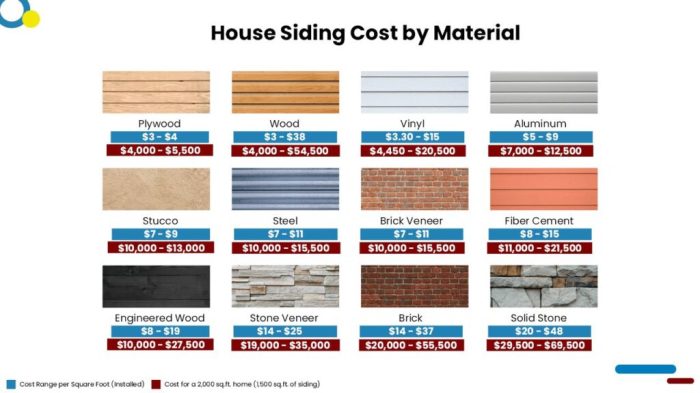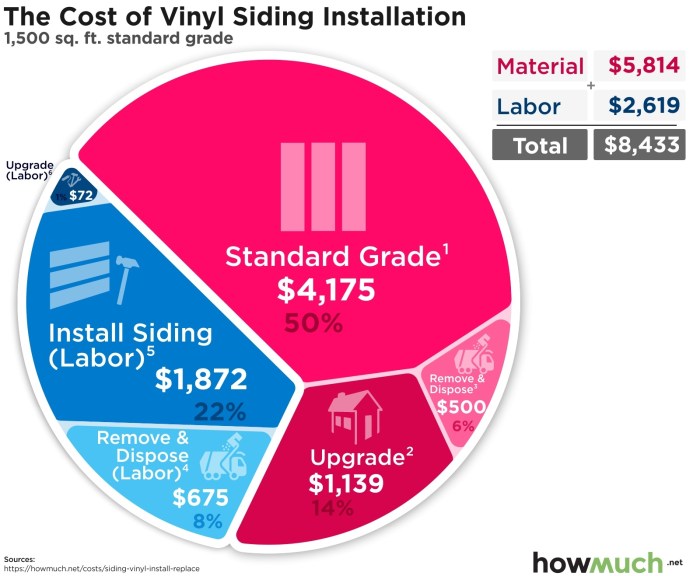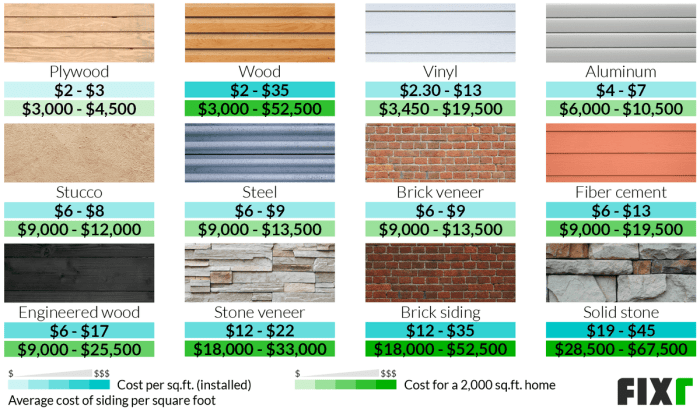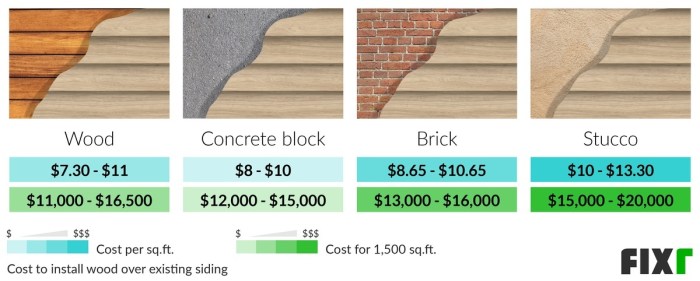Diving into the intricacies of siding installation pricing, this introduction sets the stage for a detailed exploration of the factors that influence costs. From material choices to labor expenses, readers will gain valuable insights into the world of siding installations.
The following paragraphs will delve deeper into the different aspects of siding installation pricing, providing a comprehensive guide for homeowners and contractors alike.
Factors Affecting Siding Installation Pricing

When it comes to determining the cost of siding installation, several key factors come into play. These factors can significantly impact the overall price of the project, making it important to understand how they influence the final cost.
Material Choice
The type of siding material you choose will have a major impact on the overall cost of the installation. Different materials come with varying price points, with options like vinyl, wood, fiber cement, and metal each offering unique benefits and costs.
For example, vinyl siding tends to be more affordable compared to fiber cement or wood siding, but it may not provide the same level of durability or aesthetic appeal.
Square Footage
The size of your home or the area that needs to be covered with siding will directly affect the cost of the installation. Larger homes or buildings with more exterior surface area will naturally require more materials and labor to complete the job, leading to higher overall costs.
Additionally, intricate designs or architectural features can also impact the square footage calculations and, subsequently, the pricing.
Labor Costs
The cost of labor plays a significant role in determining the final price of siding installation. Labor costs can vary based on the complexity of the project, the experience level of the contractors, and even the location of the property.
More experienced contractors may charge higher rates for their services, but they may also deliver higher quality workmanship, which can impact the overall cost.
Location
The location of your property can also influence the pricing of siding installation. Factors such as local building codes, permit requirements, accessibility of the site, and even the local cost of living can all impact the overall cost of the project.
Urban areas or regions with higher construction costs may see higher pricing for siding installation compared to rural or more affordable locations.
Types of Siding Materials

When it comes to siding materials, there are several options available to homeowners. Each type of material comes with its own set of characteristics, durability, and cost implications. Let's take a closer look at some of the most commonly used siding materials in the market.
Vinyl Siding
Vinyl siding is a popular choice for homeowners due to its affordability and low maintenance requirements. It is available in a wide range of colors and styles, making it versatile for different aesthetic preferences. While vinyl siding is durable and resistant to rot and insect damage, it may not be as long-lasting as other materials like wood or fiber cement.
Wood Siding
Wood siding provides a classic and natural look to homes, adding warmth and character. It is a renewable resource and can be easily painted or stained to match the desired color scheme. However, wood siding requires regular maintenance to prevent rot, mold, and insect infestations.
It is also more susceptible to weather damage compared to other materials.
Fiber Cement Siding
Fiber cement siding is a durable and low-maintenance option that can mimic the look of wood or stucco. It is resistant to fire, rot, and insects, making it a long-lasting choice for homeowners. While fiber cement siding may have a higher upfront cost than vinyl, its durability and longevity can make it a cost-effective investment in the long run.
Metal Siding
Metal siding, such as aluminum or steel, offers a modern and sleek appearance to homes. It is lightweight, durable, and resistant to fire, rot, and insects. Metal siding is also eco-friendly and recyclable, making it a sustainable choice for environmentally conscious homeowners.
However, metal siding may dent or scratch easily, requiring occasional maintenance to retain its appearance.
Labor Costs and Installation Process
When it comes to siding installation, labor costs play a significant role in determining the overall price of the project. Understanding the components of labor costs and the installation process can help homeowners make informed decisions when planning for a siding project.
Components of Labor Costs
- Preparation: This includes site assessment, measurements, and necessary preparations before the actual installation.
- Removal of old siding: Labor costs may vary depending on the complexity of removing existing siding materials.
- Installation: The actual process of installing the new siding materials, which requires skilled labor and precision.
- Finishing touches: This involves the final touches and cleanup after the siding installation is complete.
Installation Process
- Preparation: The area where the siding will be installed is prepared by cleaning, removing obstacles, and ensuring a smooth surface.
- Weatherproofing: Proper insulation and waterproofing materials are applied to protect the home from external elements.
- Installation: Siding materials are carefully installed according to manufacturer guidelines, ensuring a secure and visually appealing finish.
- Trimming and finishing: The edges and corners are trimmed and finished to provide a polished look to the siding installation.
Complexity and Labor Expenses
The complexity of a siding installation project can significantly impact labor expenses. Factors such as the size of the property, the type of siding material chosen, the architectural design of the home, and any additional customization required can all contribute to increased labor costs.
Homeowners should consider these factors when budgeting for a siding installation project to ensure a realistic estimate of the overall expenses involved.
Cost Estimates and Budgeting Tips

When it comes to planning for a siding installation project, obtaining accurate cost estimates and budgeting effectively are crucial steps in ensuring a successful outcome. Here are some tips to help homeowners navigate the process:
Obtaining Accurate Cost Estimates
- Get Multiple Quotes: Reach out to several contractors to request detailed quotes for the project. This will give you a better understanding of the average cost and help you make an informed decision.
- Specify Project Details: Provide contractors with specific details about the size of your home, the type of siding material you prefer, and any additional services required. This will enable them to provide a more accurate estimate.
- Consider Hidden Costs: Factor in additional costs such as permits, disposal of old siding, and any structural repairs that may be needed. It's essential to account for all potential expenses to avoid budget surprises later on.
Budgeting Effectively
- Set a Realistic Budget: Determine how much you can afford to spend on the siding project and stick to it. Consider your financial situation and prioritize essential aspects of the project to stay within budget.
- Plan for Contingencies: Allocate a portion of your budget for unexpected expenses or changes in the project scope. Having a contingency fund will help you address any unforeseen issues without derailing the entire project.
- Explore Financing Options: If the cost of the project exceeds your budget, look into financing options such as loans or payment plans offered by contractors. Make sure to evaluate the terms and interest rates to choose the best option for your situation.
Negotiating Prices with Contractors
- Compare Quotes: Use the quotes obtained from different contractors as leverage to negotiate a better price. Highlight any discrepancies in pricing and ask for explanations to ensure transparency.
- Discuss Payment Terms: Negotiate payment terms that work for both parties, such as a payment schedule based on project milestones. Avoid making full payment upfront and consider withholding a portion until the project is completed to your satisfaction.
- Ask for Discounts: Inquire about any available discounts or promotions that contractors may offer. Some contractors are willing to reduce prices to secure a project, especially during slower seasons.
End of Discussion

In conclusion, understanding the nuances of siding installation pricing is crucial for anyone embarking on a home improvement project. By considering factors like material costs and labor expenses, individuals can make informed decisions and budget effectively for their siding installation needs.
FAQs
What factors can influence the price of siding installation?
Factors like material choice, square footage, labor costs, and location can all impact the overall cost of siding installation.
What are some common types of siding materials used for installations?
Common siding materials include vinyl, wood, fiber cement, and metal, each with their own characteristics, durability, and cost implications.
How can homeowners obtain accurate cost estimates for siding installations?
Homeowners can obtain accurate cost estimates by getting multiple quotes from contractors, considering the materials and labor involved, and factoring in any additional expenses.
What are some budgeting tips for a siding project?
Budgeting tips include setting aside a contingency fund, researching costs beforehand, and negotiating prices with contractors to stay within budget.













